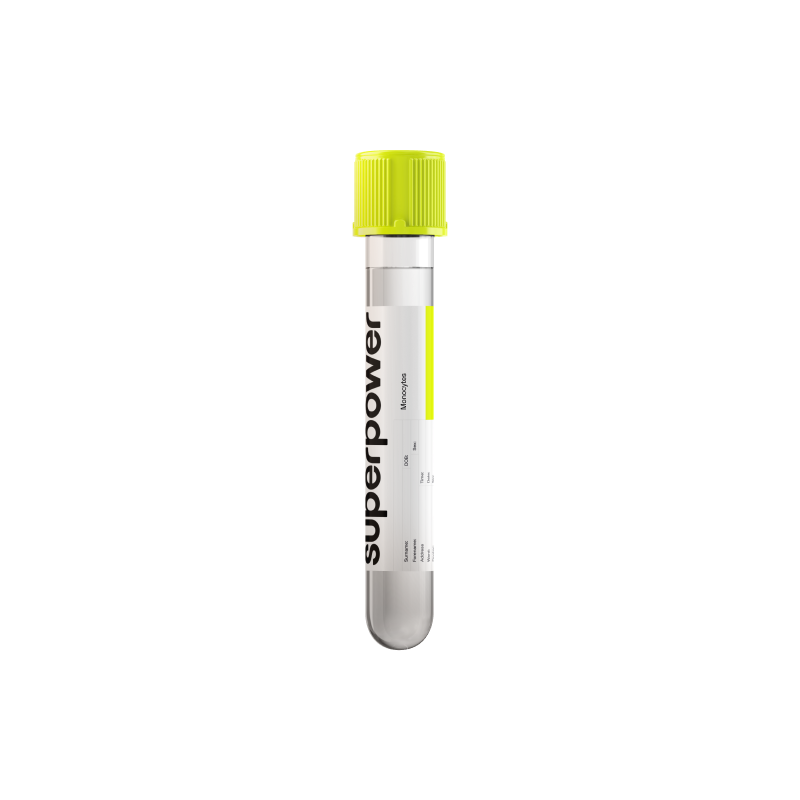Monocytes testing measures both the percentage and absolute count of these frontline immune cells as part of a complete blood count (CBC) with differential. Monocytes circulate briefly in the blood before entering tissues, where they mature into macrophages and dendritic cells. They clear pathogens, present antigens, and coordinate repair.
Levels shift with infection, inflammation, autoimmune disease, and certain blood disorders. Establishing a baseline and tracking trends helps link symptoms like fatigue, poor recovery, or chronic inflammation to immune biology.
Key Benefits
- Understand your body’s frontline immune activity by measuring monocyte levels.
- Spot chronic inflammation or infection when monocytes stay high over time.
- Flag recovery after acute illness as monocytes rise during healing.
- Explain fevers, fatigue, or weight loss by revealing hidden immune activation.
- Guide next steps when counts are extreme, prompting targeted tests or referral.
- Track autoimmune or inflammatory disease activity alongside symptoms and therapy.
- Flag bone marrow or medication effects that suppress monocytes, like chemo or steroids.
- Interpret results best with the full CBC differential and your symptoms.
What is Monocytes?
Monocytes are a major type of white blood cell (leukocyte) made in the bone marrow from myeloid precursors (hematopoietic stem cell lineage). After release, they circulate in the bloodstream briefly before entering tissues, where they mature into long‑lived cleanup and sentinel cells: macrophages and dendritic cells. In a blood test, “monocytes” refers to this circulating pool.
Monocytes patrol the blood, sense danger, and serve as first‑line defenders in the innate immune system. They engulf and digest microbes and debris (phagocytosis), remove dying cells (efferocytosis), and release signaling proteins (cytokines and chemokines) that organize inflammation. Once in tissues, as macrophages or dendritic cells, they help repair wounds and “teach” the adaptive immune system by displaying pieces of invaders to T cells (antigen presentation via MHC). Because of these roles, monocytes reflect the body’s readiness for frontline defense and cleanup, and their movement into tissues links rapid innate responses with longer‑term, targeted immunity.
Why is Monocytes important?
Monocytes are the bloodstream’s patrol and cleanup crew. They sense danger, exit blood vessels, become macrophages and dendritic cells in tissues, digest microbes and debris, present antigens to lymphocytes, and coordinate repair. Because they circulate everywhere, their number reflects whole‑body immune tone—from infection surveillance to vascular and tissue healing.
On a blood count they make up a small fraction of white cells, usually in the mid‑single digits. Healthy values tend to sit steadily in the middle of the reference range, rising briefly during recovery from illness but not lingering at the extremes.
When the count is low, the body often has reduced bone‑marrow output or a stress‑hormone–driven redistribution. This can follow chemotherapy, high‑dose steroids, severe infections, or marrow disorders. The physiologic consequence is a thinner first‑responder layer: less debris clearance and antigen presentation. People may notice slower wound healing, recurrent infections, mouth ulcers, or unusual fatigue; children can be more prone to stubborn infections during dips.
When the count is high, it signals sustained immune activation. Chronic infections, inflammatory and autoimmune diseases, and some myeloid blood cancers can drive expansion. During recovery from an acute illness, a temporary rise appears as tissues repair. System effects include low‑grade inflammation of vessels and organs, with fevers, night sweats, joint aches, abdominal discomfort, or an enlarged spleen. In pregnancy overall white cells rise mainly via neutrophils; monocytes usually stay near customary ranges. Kids often show brief surges with infections.
Big picture: As gatekeepers between innate and adaptive immunity, monocytes connect infection defense, tissue repair, and cardiometabolic health. Persistent abnormalities—especially with symptoms—track with inflammatory burden and, over time, relate to risks such as atherosclerosis and organ dysfunction.
What Insights Will I Get?
Monocytes measure the circulating pool of a key innate immune cell that patrols the bloodstream, then moves into tissues to become macrophages and dendritic cells. They coordinate inflammation, clear microbes and debris, and help reset tissue metabolism after injury. Persistently higher activity can link to vascular remodeling and plaque biology, while too little can blunt frontline defense.
Low values usually reflect reduced production or increased sequestration/suppression of these cells. This happens with bone‑marrow suppression, high cortisol or steroid exposure (glucocorticoid effect), severe stress, or as a relative finding when other white cells are expanded. In isolation and mild degrees, low counts often have limited system impact if total white cells are otherwise normal.
Being in range suggests balanced innate immune surveillance and orderly tissue repair. It generally points to stable inflammatory tone and appropriate capacity to respond to infection and heal. Clinically, optimal tends to sit near the mid‑range of most reference intervals.
High values usually reflect sustained innate immune activation. Common drivers include chronic infection, autoimmune or granulomatous inflammation, tissue injury and recovery, smoking, and cardiometabolic stress. Counts often rise transiently after an acute illness and can be persistently high with atherosclerotic risk states or hematologic disorders (for example, chronic myelomonocytic leukemia).
Notes: Interpret the absolute monocyte count more than the percentage, which can shift when other white cells change. Recent infection, vaccination, surgery, or splenectomy can raise values; glucocorticoids can lower them. Pregnancy often shows a modest increase. Reference ranges vary by age and laboratory, and there is day‑to‑day and diurnal variability.



.svg)



.png)
.png)
.png)
.png)








